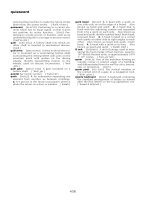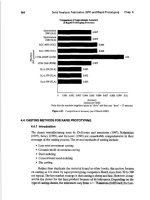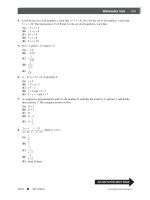Maintenance Fundamentals Episode 1 part 9 potx
Bạn đang xem bản rút gọn của tài liệu. Xem và tải ngay bản đầy đủ của tài liệu tại đây (284.96 KB, 20 trang )
obtained with a very small quantity of lubricant. Excess lubricant causes exces-
sive heating, which accelerates lubricant deterioration.
The most popular type of lubrication is the sealed grease ball-bearing cartridge.
Grease is commonly used for lubrication because of its convenience and min-
imum maintenance requirements. A high-quality lithium-based NLGI 2 grease is
commonly used for temperatures up to 1808F (828C). Grease must be replen-
ished and relubrication intervals in hours of operation are dependent on tem-
perature, speed, and bearing size. Table 9.9 is a general guide to the time after
which it is advisable to add a small amount of grease.
Some applications, however, cannot use the cartridge design—for example, when
the operating environment is too hot for the seals. Another example is when
minute leaks or the accumulation of traces of dirt at the lip seals cannot be
tolerated (e.g., food processing machines). In these cases, bearings with special-
ized sealing and lubrication systems must be used.
In applications involving high speed, oil lubrication is typically required. Table
9.10 is a general guide in selecting oil of the proper viscosity for these bearings.
For applications involving high-speed shafts, bearing selection must take into
Table 9.9 Ball-Bearing Grease Relubrication Intervals (Hours of Operation)
Bearing
Bore, mm
Bearing Speed, rpm
5,000 3,600 1,750 1,000 200
10 8,700 12,000 25,000 44,000 220,000
20 5,500 8,000 17,000 30,000 150,000
30 4,000 6,000 13,000 24,000 127,000
40 2,800 4,500 11,000 20,000 111,000
50 3,500 9,300 18,000 97,000
60 2,600 8,000 16,000 88,000
70 6,700 14,000 81,000
80 5,700 12,000 75,000
90 4,800 11,000 70,000
100 4,000 10,000 66,000
Source: Marks’ Standard Handbook for Mechanical Engineers, 8th Edition,
Theodore Baumeister, Ed. McGraw-Hill, New York, 1978.
Keith Mobley /Maintenance Fundamentals Final Proof 15.6.2004 5:18pm page 154
154 Maintenance Fundamentals
account the inherent speed limitations of certain bearing designs, cooling needs,
and lubrication issues such as churning and aeration suppression. A typical case
is the effect of cage design and roller-end thrust-flange contact on the lubrication
requirements in tapered roller bearings. These design elements limit the speed
and the thrust load that these bearings can endure. As a result, it is important to
always refer to the bearing manufacturer’s instructions on load-carrying design
and lubrication specifications.
INSTALLATION AND GENERAL HANDLING PRECAUTIONS
Proper handling and installation practices are crucial to optimal bearing per-
formance and life. In addition to standard handling and installation practices,
the issue of emergency bearing substitutions is an area of critical importance. If
substitute bearings are used as an emergency means of getting a machine back
into production quickly, the substitution should be entered into the historical
records for that machine. This documents the temporary change and avoids the
possibility of the substitute bearing becoming a permanent replacement. This
error can be extremely costly, particularly if the incorrectly specified bearing
continually fails prematurely. It is important that an inferior substitute be
removed as soon as possible and replaced with the originally specified bearing.
PLAIN BEARING INSTALLATION
It is important to keep plain bearings from shifting sideways during installation
and to ensure an axial position that does not interfere with shaft fillets. Both of
Table 9.10 Oil Lubrication Viscosity (ISO Identification Numbers)
Bearing
Bore, mm
Bearing Speed, rpm
10,000 3,600 1,800 600 50
4–7 68 150 220
10–20 32 68 150 220 460
25–45 10 32 68 150 320
50–70 7 22 68 150 320
75–90 3 10 22 68 220
100 3 7 22 68 220
Source: Marks’ Standard Handbook for Mechanical Engineers, 8th Edition,
Theodore Baumeister, Ed. McGraw-Hill, New York, 1978.
Keith Mobley /Maintenance Fundamentals Final Proof 15.6.2004 5:18pm page 155
Bearings 155
these can be accomplished with a locating lug at the parting line. Less frequently
used is a dowel in the housing, which protrudes partially into a mating hole in the
bearing.
The distance across the outside parting edges of a plain bearing are manufac-
tured slightly greater than the housing bore diameter. During installation, a light
force is necessary to snap it into place and, once installed, the bearing stays in
place because of the pressure against the housing bore.
It is necessary to prevent a bearing from spinning during operation, which can
cause a catastrophic failure. Spinning is prevented by what is referred to as
‘‘crush.’’ Bearings are slightly longer circumferentially than their mating housings,
and on installation, this excess length is elastically deformed or ‘‘crushed.’’ This
sets up a high radial contact pressure between the bearing and housing, which
ensures good back contact for heat conduction and, in combination with the bore-
to-bearing friction, prevents spinning. It is important that under no circumstances
should the bearing parting lines be filed or otherwise altered to remove the crush.
ROLLER BEARING INSTALLATION
A basic rule of rolling element bearing installation is that one ring must be
mounted on its mating shaft or in its housing with an interference fit to prevent
rotation. This is necessary because it is virtually impossible to prevent rotation
by clamping the ring axially.
Mounting Hardware
Bearings come as separate parts that require mounting hardware or as pre-
mounted units that are supplied with their own housings, adapters, and seals.
Bearing Mountings
Typical bearing mountings, which are shown in Figure 9.24, locate and hold the
shaft axially and allow for thermal expansion and/or contraction of the shaft.
Locating and holding the shaft axially is generally accomplished by clamping one
of the bearings on the shaft so that all machine parts remain in proper relation-
ship dimensionally. The inner ring is locked axially relative to the shaft by
locating it between a shaft shoulder and some type of removable locking device
once the inner ring has a tight fit. Typical removable locking devices are specially
designed nuts, which are used for a through shaft, and clamp plates, which are
commonly used when the bearing is mounted on the end of the shaft. For the
locating or held bearing, the outer ring is clamped axially, usually between
housing shoulders or end-cap pilots.
Keith Mobley /Maintenance Fundamentals Final Proof 15.6.2004 5:18pm page 156
156 Maintenance Fundamentals
With general types of cylindrical roller bearings, shaft expansion is absorbed
internally simply by allowing one ring to move relative to the other (Figure 9.24a
and 9.24c, non-locating positions). The advantage of this type of mounting is
that both inner and outer rings may have a tight fit, which is desirable or even
mandatory if significant vibration and/or imbalance exists in addition to the
applied load.
Premounted Bearing
Premounted bearings, referred to as pillow-block and flanged-housing mountings,
are of considerable importance to millwrights. They are particularly adaptable to
‘‘line-shafting’’ applications, which are a series of ball and roller bearings sup-
plied with their own housings, adapters, and seals. Premounted bearings come
with a wide variety of flange mountings, which permit them to be located on
faces parallel or perpendicular to the shaft axis. Figure 9.25 shows a typical
pillow block. Figure 9.26 shows a flanged bearing unit.
Inner races can be mounted directly on ground shafts or can be adapter-mounted
to ‘‘drill-rod’’ or to commercial shafting. For installations sensitive to imbalance
and vibration, the use of accurately ground shaft seats is recommended.
Figure 9.24 Typical bearing mounting.
Keith Mobley /Maintenance Fundamentals Final Proof 15.6.2004 5:18pm page 157
Bearings 157
Figure 9.25 Typical pillow block.
Figure 9.26 Flanged bearing unit.
Keith Mobley /Maintenance Fundamentals Final Proof 15.6.2004 5:18pm page 158
158 Maintenance Fundamentals
Most pillow-block designs incorporate self-aligning bearing types and do not
require the precision mountings utilized with other bearing installations.
Mounting Techniques
When mounting or dismounting a roller bearing, the most important thing to
remember is to apply the mounting or dismounting force to the side face of the
ring with the interference fit. This force should not pass from one ring to the
other through the ball or roller set, because internal damage can easily occur.
Mounting tapered-bore bearings can be accomplished simply by tightening the
locknut or clamping plate. This locates it on the shaft until the bearing is forced
the proper distance up the taper. This technique requires a significant amount of
force, particularly for large bearings.
Cold Mounting
Cold mounting, or force-fitting a bearing onto a shaft or into a housing, is
appropriate for all small bearings (i.e., 4-inch bore and smaller). The force,
however, must be applied as uniformly as possible around the side face of the
bearing and to the ring to be press-fit. Mounting fixtures, such as a simple piece of
tubing of appropriate size and a flat plate, should be used. It is not appropriate to
use a drift and hammer to force the bearing on, which will cause the bearing to
cock. It is possible to apply force by striking the plate with a hammer or by an arbor
press. However, before forcing the the bearing on the shaft, a coat of light oil
should be applied to the bearing seat on the shaft and the bearing bores. All sealed
and shielded ball bearings should be cold mounted in this manner.
Temperature Mounting
The simplest way to mount any open straight-bore bearing regardless of its size is
temperature mounting, which entails heating the entire bearing, pushing it on its
seat, and holding it in place until it cools enough to grip the shaft. The housing
may be heated if practical for tight outside-diameter fits; however, temperatures
should not exceed 2508F. If heating of the housing is not practical, the bearing
may be cooled with dry ice. The risk of cooling is that if the ambient conditions
are humid, moisture is introduced and there is a potential for corrosion in the
future. Acceptable ways of heating bearings are by hot plate, temperature-
controlled oven, induction heaters, and hot-oil bath.
With the hot plate method, the bearing is simply laid on the plate until it reaches
the approved temperature, with a pyrometer or Tempilstik used to make certain
it is not overheated. Difficulty in controlling the temperature is the major
disadvantage of this method.
Keith Mobley /Maintenance Fundamentals Final Proof 15.6.2004 5:18pm page 159
Bearings 159
When using a temperature-controlled oven, the bearings should be left in the
oven long enough to heat thoroughly, but they should never be left overnight.
The use of induction heaters is a quick method of heating bearings. However,
some method of measuring the ring temperature (e.g., pyrometer or a Tempil-
stik) must be used or damage to the bearing may occur. Note that bearings must
be demagnetized after the use of this method.
The use of a hot-oil bath is the most practical means of heating larger bearings.
Disadvantages are that the temperature of the oil is hard to control, and it may
ignite or overheat the bearing. The use of a soluble oil-and-water mixture
(10–15% oil) can eliminate these problems and still attain a boiling temperature
of 2108F. The bearing should be kept off the bottom of the container by a grate
or screen located several inches off the bottom. This is important to allow
contaminants to sink to the bottom of the container and away from the bearing.
Dismounting
Commercially available bearing pullers allow rolling element bearings to be
dismounted from their seats without damage. When removing a bearing, force
should be applied to the ring with the tight fit, although sometimes it is necessary
to use supplementary plates or fixtures. An arbor press is equally effective at
removing smaller bearings as well as mounting them.
Ball Installation
Figure 9.27 shows the ball installation procedure for roller bearings. The
designed load carrying capacity of Conrad-type bearings is determined by the
number of balls that can be installed between the rings. Ball installation is
accomplished by the following procedure:
Slip the inner ring slightly to one side
Insert balls into the gap, which centers the inner ring as the balls are
positioned between the rings
Place stamped retainer rings on either side of the balls before riveting
together. This positions the balls equidistant around the bearing.
GENERAL ROLLER-ELEMENT BEARING HANDLING PRECAUTIONS
For roller-element bearings to achieve their design life and perform with no
abnormal noise, temperature rise, or shaft excursions, the following precautions
should be taken:
Keith Mobley /Maintenance Fundamentals Final Proof 15.6.2004 5:18pm page 160
160 Maintenance Fundamentals
Always select the best bearing design for the application and not the
cheapest. The cost of the original bearing is usually small by compari-
son to the costs of replacement components and the down-time in
production when premature bearing failure occurs because an inappro-
priate bearing was used.
If in doubt about bearings and their uses, consult the manufacturer’s
representative and the product literature.
Bearings should always be handled with great care. Never ignore the
handling and installation instructions from the manufacturer.
Always work with clean hands, clean tools, and the cleanest environ-
ment available.
Never wash or wipe bearings prior to installation unless the instruc-
tions specifically state that this should be done. Exceptions to this rule
are when oil-mist lubrication is to be used and the slushing compound
has hardened in storage or is blocking lubrication holes in the bearing
rings. In this situation, it is best to clean the bearing with kerosene or
2. Balls are installed in the gap.
4. A retainer in installed
1. The inner ring is moved to one side
3. The inner ring is centered as the balls
are equally positioned in place.
Figure 9.27 Ball installation procedures.
Keith Mobley /Maintenance Fundamentals Final Proof 15.6.2004 5:18pm page 161
Bearings 161
other appropriate petroleum-based solvent. The other exception is if
the slushing compound has been contaminated with dirt or foreign
matter before mounting.
Keep new bearings in their greased paper wrappings until they are
ready to install. Place unwrapped bearings on clean paper or lint-free
cloth if they cannot be kept in their original containers. Wrap bearings
in clean, oil-proof paper when not in use.
Never use wooden mallets, brittle or chipped tools, or dirty fixtures and
tools when bearings are being installed.
Do not spin bearings (particularly dirty ones) with compressed service
air.
Avoid scratching or nicking bearing surfaces. Care must be taken when
polishing bearings with emery cloth to avoid scratching.
Never strike or press on race flanges.
Always use adapters for mounting that ensure uniform steady pressure
rather than hammering on a drift or sleeve. Never use brass or bronze
drifts to install bearings as these materials chip very easily into minute
particles that will quickly damage a bearing.
Avoid cocking bearings onto shafts during installation.
Always inspect the mounting surface on the shaft and housing to
ensure that there are no burrs or defects.
When bearings are being removed, clean housings and shafts before
exposing the bearings. Dirt is abrasive and detrimental to the designed
life span of bearings.
Always treat used bearings as if they are new, especially if they are to
be reused.
Protect dismantled bearings from moisture and dirt.
Use clean, filtered, water-free Stoddard’s solvent or flushing oil to clean
bearings.
When heating is used to mount bearings onto shafts, follow the manu-
facturer’s instructions.
When assembling and mounting bearings onto shafts, never strike the
outer race or press on it to force the inner race. Apply the pressure on
the inner race only. When dismantling, follow the same procedure.
Never press, strike, or otherwise force the seal or shield on factory-
sealed bearings.
BEARING FAILURES,DEFICIENCIES, AND THEIR CAUSES
The general classifications of failures and deficiencies requiring bearing removal
are overheating, vibration, turning on the shaft, binding of the shaft, noise
during operation, and lubricant leakage. Table 9.11 is a troubleshooting guide
Keith Mobley /Maintenance Fundamentals Final Proof 15.6.2004 5:18pm page 162
162 Maintenance Fundamentals
Table 9.11 Troubleshooting Guide
Overheating
Vibration Turning on the Shaft Binding of the Shaft
Noisy Bearing Lubricant Leakage
Inadequate or
insufficient
lubrication
Dirt or chips in
bearing
Growth of race due to
overheating
Lubricant breakdown Lubricant
breakdown
Overfilling of
lubricant
Excessive
lubrication
Fatigued race or
rolling elements
Fretting wear
Contamination by
abrasive or corrosive
materials
Inadequate
lubrication
Grease churning
due to too soft
consistency
Grease liquification
or aeration
Rotor unbalance Improper initial fit Housing distortion
or
out-of-round pinching
bearing
Pinched bearing Grease
deterioration due to
excessive operating
temperature
Oil foaming Out-of-round shaft Excessive shaft
deflection
Uneven shimming of
housing with loss of
clearance
Contamination Operating beyond
grease life
Abrasion or
corrosion due to
contaminants
Race misalignment Initial coarse finish on
shaft
Tight rubbing seals Seal rubbing Seal wear
Housing distortion
due to warping or
out-of-round
Housing resonance Seal rub on inner race Preloaded bearings
Bearing slipping on
shaft or in housing
Wrong shaft
attitude (bearing
seals designed for
horizontal
mounting only)
(continues)
Keith Mobley /Maintenance Fundamentals Final Proof 15.6.2004 5:18pm page 163
Bearings 163
Table 9.11 (continued)
Overheating
Vibration Turning on the Shaft Binding of the Shaft
Noisy Bearing Lubricant Leakage
Seal rubbing or
failure
Cage wear
Cocked races
Flatted roller or
ball
Seal failure
Inadequate or
blocked scavenge
oil passages
Flats on races or
rolling elements
Loss of clearance due
to excessive adapter
tightening
Brinelling due to
assembly abuse,
handling, or shock
loads
Clogged breather
Inadequate bearing
clearance or
bearing preload
Race turning
Thermal shaft
expansion
Variation in size of
rolling elements
Oil foaming due to
churning or air flow
through housing
Race turning Excessive clearance
Out-of-round or
lobular shaft
Gasket (O-ring)
failure or
misapplication
Cage wear
Corrosion
Housing bore
waviness
Porous housing or
closure
False-brinelling or
indentation of races
Chips or scores
under bearing seat
Lubricator set at
the wrong flow rate
Electrical arcing
Mixed rolling element
diameters
Out-of-square rolling
paths in races
Source:
Integrated Systems, Inc.
Keith Mobley /Maintenance Fundamentals Final Proof 15.6.2004 5:18pm page 164
164 Maintenance Fundamentals
that lists the common causes for each of these failures and deficiencies. As
indicated by the causes of failure listed, bearing failures are rarely caused by
the bearing itself.
Many abnormal vibrations generated by actual bearing problems are the result
of improper sizing of the bearing liner or improper lubrication. However, nu-
merous machine and process-related problems generate abnormal vibration
spectra in bearing data. The primary contributors to abnormal bearing signa-
tures are (1) imbalance, (2) misalignment, (3) rotor instability, (4) excessive or
abnormal loads, and (5) mechanical looseness.
Defective bearings that leave the manufacturer are very rare, and it is estimated
that defective bearings contribute to only 2% of total failures. The failure is
invariably linked to symptoms of misalignment, imbalance, resonance, and
lubrication—or the lack of it. Most of the problems that occur result from the
following reasons: dirt, shipping damage, storage and handling, poor fit resulting
in installation damage, wrong type of bearing design, overloading, improper
lubrication practices, misalignment, bent shaft, imbalance, resonance, and soft
foot. Any one of these conditions will eventually destroy a bearing—two or more
of these problems can result in disaster!
Although most industrial machine designers provide adequate bearings for their
equipment, there are some cases where bearings are improperly designed, manu-
factured, or installed at the factory. Usually, however, the trouble is caused by
one or more of the following reasons: (1) improper on-site bearing selection and/
or installation, (2) incorrect grooving, (3) unsuitable surface finish, (4) insuffi-
cient clearance, (5) faulty relining practices, (6) operating conditions, (7) exces-
sive operating temperature, (8) contaminated oil supply, and (9) oil-film
instability.
IMPROPER BEARING SELECTION AND/OR INSTALLATION
There are several things to consider when selecting and installing bearings,
including the issue of interchangeability, materials of construction, and damage
that might have occurred during shipping, storage, and handling.
Interchangeability
Because of the standardization in envelope dimensions, precision bearings were
once regarded as interchangeable among manufacturers. This interchangeability
has since been considered a major cause of failures in machinery, and the practice
should be used with extreme caution.
Keith Mobley /Maintenance Fundamentals Final Proof 15.6.2004 5:18pm page 165
Bearings 165
Most of the problems with interchangeability stem from selecting and replacing
bearings based only on bore size and outside diameters. Often, very little con-
sideration is paid to the number of rolling elements contained in the bearings.
This can seriously affect the operational frequency vibrations of the bearing
and may generate destructive resonance in the host machine or adjacent
machines.
More bearings are destroyed during their installation than fail in operation. Instal-
lation with a heavy hammer is the usual method in many plants. Heating the
bearing with an oxyacetylene burner is another classical method. However,
the bearing does not stand a chance of reaching its life expectancy when either of
these installation practices is used. The bearing manufacturer’s installation
instructions should always be followed.
Materials of Construction
Refer to Chapter 3, which discusses the appropriate materials of construction for
the different types of bearings.
Shipping Damage
Bearings and the machinery containing them should be properly packaged to
avoid damage during shipping. However, many installed bearings are exposed to
vibration, bending, and massive shock loading through bad handling practices
during shipping. It has been estimated that approximately 40% of newly received
machines have ‘‘bad’’ bearings.
Because of this, all new machinery should be thoroughly inspected for defects
before installation. Acceptance criteria should include guidelines that clearly
define acceptable design/operational specifications. This practice pays big divi-
dends by increasing productivity and decreasing unscheduled downtime.
Storage and Handling
Stores and other appropriate personnel must be made aware of the potential
havoc they can cause by their mishandling of bearings. Bearing failure often
starts in the storeroom rather than in the machinery. Premature opening of
packages containing bearings should be avoided whenever possible. If packages
must be opened for inspection, they should be protected from exposure to
harmful dirt sources and then resealed in the original wrappings. The bearing
should never be dropped or bumped as this can cause shock loading on the
bearing surface.
Keith Mobley /Maintenance Fundamentals Final Proof 15.6.2004 5:18pm page 166
166 Maintenance Fundamentals
Incorrect Placement of Oil Grooves
Incorrectly placed oil grooves can cause bearing failure. Locating the grooves in
high-pressure areas causes them to act as pressure-relief passages. This interferes
with the formation of the hydrodynamic film, resulting in reduced load-carrying
capability.
Unsuitable Surface Finish
Smooth surface finishes on both the shaft and the bearing are important to
prevent surface variations from penetrating the oil film. Rough surfaces can
cause scoring, overheating, and bearing failure. The smoother the finishes, the
closer the shaft may approach the bearing without danger of surface contact.
Although important in all bearing applications, surface finish is critical with the
use of harder bearing materials such as bronze.
Insufficient Clearance
There must be sufficient clearance between the journal and bearing to allow an
oil film to form. An average diametral clearance of 0.001 in. per inch of shaft
diameter is often used. This value may be adjusted depending on the type of
bearing material, the load, speed, and the accuracy of the shaft position desired.
Faulty Relining
Faulty relining occurs primarily with babbitted bearings rather than precision
machine-made inserts. Babbitted bearings are fabricated by a pouring process
that should be performed under carefully controlled conditions. Some reasons
for faulty relining are (1) improper preparation of the bonding surface, (2) poor
pouring technique, (3) contamination of babbitt, and (4) pouring bearing to size
with journal in place.
Operating Conditions
Abnormal operating conditions or neglecting necessary maintenance precautions
cause most bearing failures. Bearings may experience premature and/or cata-
strophic failure on machines that are operated heavily loaded, speeded up, or
being used for a purpose not appropriate for the system design. Improper use of
lubricants can also result in bearing failure. Some typical causes of premature
failure include (1) excessive operating temperatures, (2) foreign material in the
lubricant supply, (3) corrosion, (4) material fatigue, and (5) use of unsuitable
lubricants.
Keith Mobley /Maintenance Fundamentals Final Proof 15.6.2004 5:18pm page 167
Bearings 167
Excessive Temperatures
Excessive temperatures affect the strength, hardness, and life of bearing mater-
ials. Lower temperatures are required for thick babbitt liners than for thin
precision babbitt inserts. Not only do high temperatures affect bearing materials,
they also reduce the viscosity of the lubricant and affect the thickness of the film,
which affects the bearing’s load-carrying capacity. In addition, high tempera-
tures result in more rapid oxidation of the lubricating oil, which can result in
unsatisfactory performance.
Dirt and Contamination in Oil Supply
Dirt is one of the biggest culprits in the demise of bearings. Dirt makes its
appearance in bearings in many subtle ways, and it can be introduced by bad
work habits. It also can be introduced through lubricants that have been exposed
to dirt, which is responsible for approximately half of bearing failures through-
out the industry.
To combat this problem, soft materials such as babbitt are used when it is known
that a bearing will be exposed to abrasive materials. Babbitt metal embeds hard
particles, which protects the shaft against abrasion. When harder materials are
used in the presence of abrasives, scoring and galling occurs as a result of
abrasives caught between the journal and bearing.
In addition to the use of softer bearing materials for applications in which
abrasives may potentially be present, it is important to properly maintain filters
and breathers, which should regularly be examined. To avoid oil supply contam-
ination, foreign material that collects at the bottom of the bearing sump should
be removed on a regular basis.
Oil Film Instability
The primary vibration frequency components associated with fluid-film bearing
problems are in fact displays of turbulent or non-uniform oil film. Such instabil-
ity problems are classified as either oil whirl or oil whip, depending on the
severity of the instability.
Machine-trains that use sleeve bearings are designed based on the assumption
that rotating elements and shafts operate in a balanced and therefore centered
position. Under this assumption, the machine-train shaft will operate with an
even, concentric oil film between the shaft and sleeve bearing.
For a normal machine, this assumption is valid after the rotating element has
achieved equilibrium. When the forces associated with rotation are in balance,
Keith Mobley /Maintenance Fundamentals Final Proof 15.6.2004 5:18pm page 168
168 Maintenance Fundamentals
the rotating element will center the shaft within the bearing. However, several
problems directly affect this self-centering operation. First, the machine-train
must be at designed operating speed and load to achieve equilibrium. Second,
any imbalance or abnormal operation limits the machine-train’s ability to center
itself within the bearing.
A typical example is a steam turbine. A turbine must be supported by auxiliary
running gear during start up or shut down to prevent damage to the sleeve
bearings. The lower speeds during the start up and shut down phase of operation
prevent the self-centering ability of the rotating element. Once the turbine has
achieved full speed and load, the rotating element and shaft should operate
without assistance in the center of the sleeve bearings.
Figure 9.28 Oil whirl, oil whip.
Keith Mobley /Maintenance Fundamentals Final Proof 15.6.2004 5:18pm page 169
Bearings 169
Oil Whirl
In an abnormal mode of operation, the rotating shaft may not hold the centerline
of the sleeve bearing. When this happens, an instability called oil whirl occurs. Oil
whirl is an imbalance in the hydraulic forces within a sleeve bearing. Under
normal operation, the hydraulic forces such as velocity and pressure are bal-
anced. If the rotating shaft is offset from the true centerline of the bearing,
instability occurs.
As Figure 9.28 illustrates, a restriction is created by the offset. This restriction
creates a high pressure and another force vector in the direction of rotation. Oil
whirl accelerates the wear and failure of the bearing and bearing support structure.
Oil Whip
The most severe damage results if the oil whirl is allowed to degrade into oil
whip. Oil whip occurs when the clearance between the rotating shaft and sleeve
bearing is allowed to close to a point approaching actual metal-to-metal contact.
When the clearance between the shaft and bearing approaches contact, the oil
film is no longer free to flow between the shaft and bearing. As a result, the
oil film is forced to change directions. When this occurs, the high-pressure area
created in the region behind the shaft is greatly increased. This vortex of oil
increases the abnormal force vector created by the offset and rotational force to
the point that metal-to-metal contact between the shaft and bearing occurs. In
almost all instances where oil whip is allowed, severe damage to the sleeve
bearing occurs.
Keith Mobley /Maintenance Fundamentals Final Proof 15.6.2004 5:18pm page 170
170 Maintenance Fundamentals
10
COUPLINGS
Couplings are designed to provide two functions: (1) to transmit torsional power
between a power source and driven unit, and (2) to absorb torsional variations
in the drive train. They are not designed to correct misalignment between two
shafts. While certain types of couplings provide some correction for slight
misalignment, reliance on these devices to obtain alignment is not recommended.
COUPLING TYPES
The sections that follow provide overviews of the more common coupling types,
rigid and flexible. Also discussed are couplings used for special applications,
floating-shaft (spacer) and fluid (hydraulic).
Rigid Couplings
A rigid coupling permits neither axial nor radial relative motion between the
shafts of the driver and driven unit. When the two shafts are connected solidly
and properly, they operate as a single shaft. A rigid coupling is primarily used for
vertical applications (e.g., vertical pump). Types of rigid couplings discussed in
this section are flanged, split, and compression.
Flanged couplings are used where there is free access to both shafts. Split
couplings are used where access is limited on one side. Both flanged and split
couplings require the use of keys and keyways. Compression couplings are used
when it is not possible to use keys and keyways.
Keith Mobley /Maintenance Fundamentals Final Proof 15.6.2004 7:35pm page 171
171
Flanged Couplings
A flanged rigid coupling is composed of two halves, one located on the end of the
driver shaft and the other on the end of the driven shaft. These halves are bolted
together to form a solid connection. To positively transmit torque, the coupling
incorporates axially fitted keys and split circular key rings or dowels, which
eliminate frictional dependency for transmission. The use of flanged couplings
is restricted primarily to vertical pump shafts. A typical flanged rigid coupling is
illustrated in Figure 10.1.
Split Couplings
A split rigid coupling, also referred to as a clamp coupling, is basically a
sleeve that is split horizontally along the shaft and held together with bolts. It is
clamped over the adjoining ends of the driver and driven shafts, forming a
solid connection. Clamp couplings are used primarily on vertical pump shafting.
A typical split rigid coupling is illustrated in Figure 10.2. As with the
flanged coupling, the split rigid coupling incorporates axially fitted keys and
split circular key rings to eliminate frictional dependency in the transmission
of torque.
Compression Coupling
A rigid compression coupling is composed of three pieces: a compressible core
and two encompassing coupling halves that apply force to the core. The core is
composed of a slotted bushing that has been machine-bored to fit both ends of
the shafts. It also has been machined with a taper on its external diameter from
the center outward to both ends. The coupling halves are finish-bored to fit this
taper. When the coupling halves are bolted together, the core is compressed
down on the shaft by the two halves, and the resulting frictional grip transmits
the torque without the use of keys. A typical compression coupling is illustrated
in Figure 10.3.
Flexible Couplings
Flexible couplings—which are classified as mechanical flexing, material flexing,
or combination—allow the coupled shafts to slide or move relative to each other.
Although clearances are provided to permit movement within specified tolerance
limits, flexible couplings are not designed to compensate for major misalign-
ments. (Shafts must be aligned to less than 0.002 in. for proper operation.)
Significant misalignment creates a whipping movement of the shaft, adds thrust
to the shaft and bearings, causes axial vibrations, and leads to premature wear or
failure of equipment.
Keith Mobley /Maintenance Fundamentals Final Proof 15.6.2004 7:35pm page 172
172 Maintenance Fundamentals
B
Figure 10.1 Typical flanged rigid coupling.
Keith Mobley /Maintenance Fundamentals Final Proof 15.6.2004 7:35pm page 173
Couplings 173









